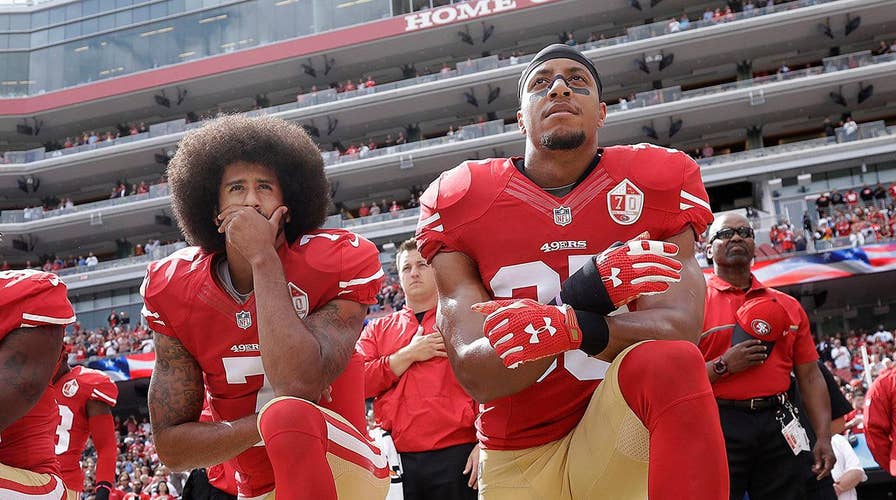Just last week, the NFL and the NFL Players’ Association met in New York City to discuss the anthem protests that have been breaking out in stadiums across the country. The meeting, it seems, proved inconclusive: The statement issued made no mention of any policy regarding the anthem protests, instead emphasizing both the league’s commitment to bringing about “positive social change” and the players’ “tremendous respect” for the flag and the military.
This is a missed opportunity for the NFL. Indeed, the league’s reaction to the protests is in many respects a textbook example of what not to do. The league allowed players and politicians alike to hijack the brand and turn it into a platform. And while players are private citizens and certainly entitled to political expression, they are not entitled to take the brand of a private company and expose it to the criticism and censure of public leaders.
In what follows, I offer a brief outline of what went wrong and what we can learn from the NFL’s process.
Slow reaction vs. quick action
It is far easier to deal with one sole player than with a whole slew of them – and it would have been far easier to deal with Kaepernick alone back in 2016 than it is to deal with the entire Players’ Association today. The delay in addressing the situation allowed the protests to grow to the point where the president, the vice president and other key leaders felt the need to comment on them.
At the end of the day, people turn the TV on because they love football, not because they agree with a player’s views on social issues. By not focusing on its core value to customers and allowing issues to take over its brand, the NFL set itself up for the sticky situation it finds itself in today.
It also allowed the players to make Kaepernick into a kind of martyr-hero, complaining that he wasn’t invited to last Tuesday’s meeting. Kapernick himself has latched onto this image, and is bringing a suit against the NFL for collusion against him.
The key to getting situations like this under control is to take quick, decisive action. Doing so allows you to better manage the situation and quite possibly preventing the kind of explosive, highly-political and public situation the NFL got itself into. It also will save you a lot of money, both in crisis management and in legal fees.
Indecision vs. Consistency
Ever since Kaepernick started the protests in 2016, the NFL has failed to take a consistent stance. On the one hand, it seemed to condone them by not immediately cracking down; on the other, it seemed to condemn them when no team hired him for the 2017-18 season. When the protests re-emerged in the 2017 preseason, the league seemed to affirm the protests when coaches, owners and players all joined together to kneel at games across the country and the globe – but then changed its mind a few weeks later when Roger Goodell released a memo asking all the players to stand. Last week, the league waffled yet again: instead of coming down decisively for or against the protests, it chose not to make a decision.
If you want to recover from any public relations crisis, you must be consistent. Flip-flopping and indecision will only feed the story and expose you to further scrutiny. Figure out what your position and your messaging is, and then stick to it – understanding that you will receive questions and criticism. Sometimes, the simplest approach is the best – and the least scarring.
Sharing your brand vs. protecting your brand
The real root of the NFL’s problem, however, is not its slow reaction time or its indecision: It is the fact that it hasn’t protected its brand. It should come as no surprise that Kapernick thought he could do what he did. Not only has the NFL used its brand to support various social and charitable causes, it also has allowed individual players to do so. But at the end of the day, people turn the TV on because they love football, not because they agree with a player’s views on social issues. By not simply focusing on its core value to customers and allowing issues and causes to gradually take over its brand, the NFL set itself up for the sticky situation it finds itself in today.
In our hyper-political moment, any brand in any sector – entertainment, business, education, health care – can quickly become politically exploited, whether by individuals, political leaders or by the news media. Learn from the NFL’s mistakes and start to think through how you will prevent your organization from becoming subject to the same kind of unnecessary politicization.
No one knows what the ultimate outcome of these NFL protests will be. Will the league keep its current policy and continue to lose money and ratings? Will it change its policy and bounce back? Will the protests grow in number or will they shrink? Will coaches take action if the league will not?
What we do know, however, is that no organization – even one as big as the NFL – is free from the possibility of losing control of its brand. When everyone – from your leadership to your newest employee – has access to digital platforms to express their opinions, it’s incredibly easy for a situation like this to develop. Take the time now to create clear policies and clear plans. It’s always better to be proactive than reactive, and to be privately decisive than publicly derided. Your staff, your stakeholders – not to mention your comms strategists – will thank you.

